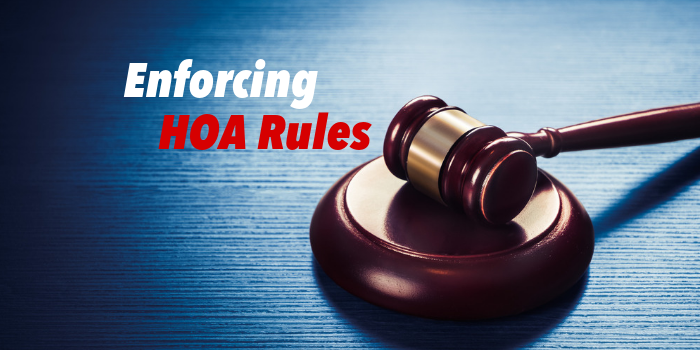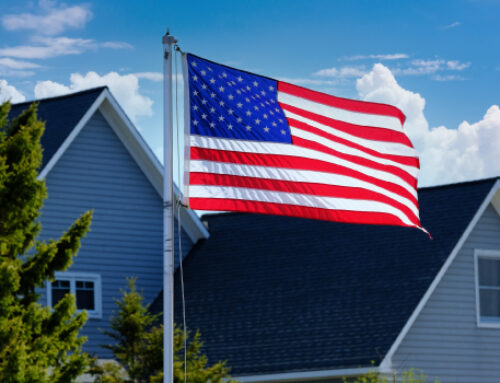Being a board member isn’t just about overseeing the annual National Night Out event or choosing a new landscape vendor who can upkeep common areas for a fair price. You also have the responsibility of making sure the rules in the association’s governing documents are followed by all members—homeowners, committee members, and board members alike.
This doesn’t always mean simply reminding homeowners of community rules and sending out assessment letters. Sometimes, as a board member, you will have to enforce the rules. As you know, this is easier said than done! This week, we’re going over best practices for HOA rule enforcement.
The Important Rules
The most important rules of your HOA, which usually include assessment collections and CC&R regulations, should also be the most straightforward to enforce. Your governing documents should outline clear procedures for billing policies and the consequences for late assessments, which can include delinquent and administrative fees, loss of amenity privileges, and home liens made through an attorney (if the issue escalates to that point).
If your HOA has difficulty enforcing assessment collection, make sure you understand and are correctly implementing the procedures in your governing documents. If the governing documents don’t give your board enough power to collect the assessments needed to run the association, you could consider amending them.
Deed restrictions maintain the community standards that homeowners commit to follow when they join the association—they help secure home values and foster pride in the neighborhood. Overgrown grass, weeds, and worn-down fences make up the most common and troublesome examples of what happens when these standards are not met.
An effective way to solve deed restriction violations in your community is to improve board-homeowner communication. Sending a friendly courtesy letter to noncompliant homeowners that explains the policy and ways to address the violation is typically all that’s needed. However, if the issue isn’t resolved through a courtesy message, your board may need to send additional reminders and post fines on the homeowner’s account—if this action is allowed by the governing documents. Remember, though, that communication and collaboration are the best paths to deed restriction compliance!
Noncompliance to architectural control rules can also be difficult to correct. Homeowners should submit projects, such as building a backyard deck or painting a home, for ACC approval before beginning them, but the proper procedures are not always followed. Homeowners might be confused about a long, complicated approval process, or they might not understand the necessity of submitting architectural projects for approval.
Communicating the steps of the process clearly to homeowners and making the approval process as quick, friendly, and painless as possible are great steps a board and/or architectural control committee can take to improve ACC compliance. Our ACC One-Touch solution is a great way to offer this kind of service to your homeowners. Feel free to contact us for more information!
Nuisances
Nuisances are the violations that are tricky – or near impossible – to enforce. These can include speeding in the neighborhood, barking dogs, and pet droppings left on homeowners’ properties. These types of violations are hard to stop because it is so difficult to prove who committed the violation.
Solutions for speeding issues can include setting up speed trackers in the neighborhood (so homeowners know how fast they’re driving), hiring a constable (for gated communities), and reporting speeding to the sheriff’s office (for non-gated communities). If the HOA cannot afford to hire a constable, an HOA board can also try communicating rules and regulations to the community. If the board can communicate the importance of ceasing harmful or dangerous behavior, occurrences should dwindle!
The best way to cure barking dogs or pet droppings is to have homeowners politely discuss the issue neighbor-to-neighbor; people personally affected by the issue have the highest chance of fixing the problem if the issue hasn’t escalated. However, sending pet care reminders to the community can also be a solution to this issue if discussing the problem doesn’t work.
Effective means of communicating with homeowners can include community signs (such as billboards and marquee signs), social media sites, social events, meetings, community websites, email blasts, letters, and newsletters.
Leading by Example
One of the best ways board members can improve compliance and effectively enforce association rules is to hold themselves to the same standards they hold homeowners. All rules should apply fairly to homeowners, committee members, and board members alike. As a board member, you have the added responsibility of holding meetings, elections, and votes according to state statutes and governing document rules. By carefully following these rules in your role as a community leader, you can show your association members that you not only care about the community, but also care about treating all members fairly and with respect.
Paying extra attention to ensure that all ACC violations are treated equally also goes a long way in gaining homeowners’ respect. Favoritism (or even perceived favoritism) of some association members can harm the esteem of an association’s board. Furthermore, a homeowner’s trust in their board will drop if some members seem to be targeted and given harsher consequences than others.
Lastly, board members should be careful to be consistent in applying new policies. Board members should weigh and draft new policies with care to ensure they follow governing document rules and will last for a long time. Homeowners might be annoyed if basketball hoops are allowed in March and then restricted again in April! Complying with ever-changing policies can be trying for even the most rule-abiding members of your association.
As an HOA board member, you have many great responsibilities, but you also have the power to make your association the fair and respectful community members deserve. It takes much more time and effort, but by checking that all enforcement measures are consistent and follow HOA rules, you will ensure better compliance not only for your current board, but for subsequent boards for years to come.







